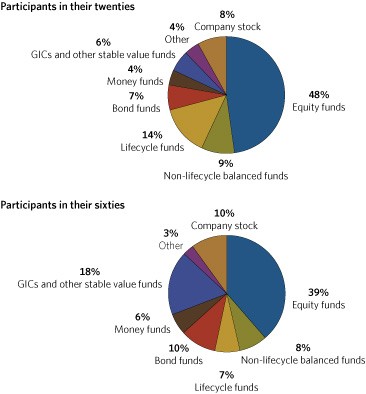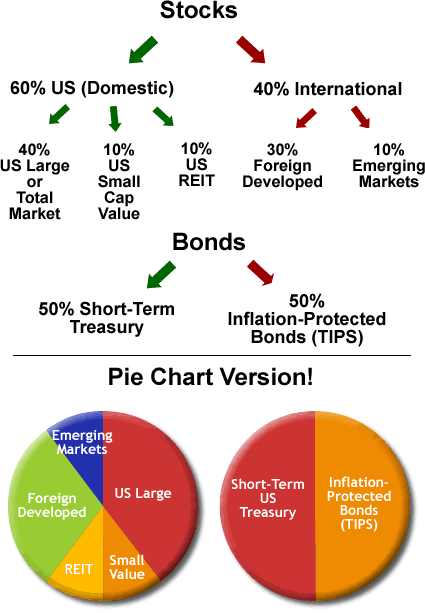Determining Asset Allocation by Age
Post on: 18 Май, 2015 No Comment

Whats the Point of Asset Allocation?
The main idea behind proper asset allocation is maximizing your portfolios return while minimizing your risk. While maximizing returns seems clear, risk is subjective and differs person to person. Everyone has their own risk tolerance based on a variety of factors, so you’ll see different investors choose different investment vehicles even if they are the same age.
A benefit of having the proper asset allocation is to fit your goals. Usually investors seek aggressive growth in the long term and shift to more stability of their money in the short term (i.e. for people retiring soon).
Looking at Target Mutual Funds
To give you an idea of possible asset allocations, I use Vanguards guidelines for their target mutual funds. Vanguard has earned a reputation for good performance and customer service and I know several people in my family who enjoy investing with them. These guidelines are just rules of thumbs, not to be used as a definitive answer to your investing needs.
Im not going to list all of the funds, just a few to give you an idea of how your portfolio should shift as you age. With stock and bonds listed in the examples below, I would suggest looking at index funds to reduce costs instead of hunting of individual stocks and bonds to put your money in.
If youre more aggressive, you may want to include some specific stocks that pay a dividend in your portfolio. What is a dividend. Its money a corporation pays shareholders after taxes. In addition to having your stock increase in value you also can receive additional payments. You can decide what you want to do with that money.
Asset Allocation (Ages 18- 22)
Retirement is usually in the back of many peoples mind as they are just starting off their careers. However, investing early can have a tremendous impact on your portfolio and you can use compound interest in your favor.
Heres Vanguards 2055 fund s breakdown:
- 90% Stocks
- 10% Bonds
Asset Allocation (Ages 28-32)
As one becomes more established in their careers it would be a great time to ratchet up contribution amounts as they receive raises. For instance if you started with a 3% or 5% contribution, could you raise it up to 5% or 10%? Hopefully you wont notice a bigger chunk going towards retirement because its automatically deducted from your higher salary.
Heres Vanguards 2045 fund s breakdown:
- 89.67% Stocks
- 10.15% Bonds
- 0.18% Short Term Reserves

You still have decades before you retire, so dont jump into conservative investments like bonds quite yet.
Asset Allocation (ages 38-42)
If you havent eliminated your non-mortgage debt, you could be hurting your retirement funding. Your monthly budget could be squeezed and you may be tempted to put off increasing your contributions. If so, get on a debt reduction plan like the Total Money Makeover or do your own debt snowball.
If youre in a sound financial state and either have only have mortgage debt or no debt, then consider maximizing your annual contributions to take advantage of employer matches and tax breaks.
Heres Vanguards 2035 fund s breakdown:
- 88.68% Stocks
- 11.22% Bonds
- 0.10% Short Term Reserves
Asset Allocation (Ages 48-52)
Hopefully by this time youve become accustom to contributing 10-15% of your monthly income for your upcoming retirement. If not, now is the time to get serious about your monthly budget and including enough to set aside for your upcoming retirement.
Heres Vanguards 2025 fund s breakdown:
- 73.60% Stocks
- 26.29% Bonds
- 0.11% Short Term Reserves
My Own IRAs Asset Allocation Model
In case youre curious, Ill share my own IRA plans for asset allocation. I based mine on David Swensen’s model. Swensen has had a long track record of solid returns at Yale. The general asset allocation Swensen recommends includes:
- Domestic Equity (30 percent)
- Real Estate Investment Trusts (20 percent)
- Foreign Developed Equity (15 percent)
- U.S. Treasury Notes and Bonds (15 percent)
- Emerging Market Equity (5 percent)
- U.S. Treasury Inflation-Protection Securities (TIPS) (15 percent)
Since I have decades before I expect to draw money from this account, I dont really have much in the way of bonds and the more conservative investments. (Clarification due to reader comment Im working toward the Swensen model, but currently have more invested in foreign developed equity and emerging markets than Swensen suggested. As I continue with contribution Ill add more conservative investments. )
I use a combination of index funds and exchange traded funds. If youre looking at this model for yourself, Get Rich Slowly has some index funds and ETFs that you can build with.
Asset Allocation Based on Age for Retirement
How are preparing your retirement fund in terms of asset allocation? Is there a particular model that youre following? What have been your returns over the past 5, 10, or 20 years?
Remember these are only guidelines and you may decide to invest more aggressively or conservatively based on different factors, including your own risk tolerance. Im not a financial professional, so if you’re looking for a professional trained to help with your finances and you live in the United States, try using The National Association of Personal Financial Advisors (NAPFA) to find a fee based financial planner. They should be able to work with you and your individual financial situation.














